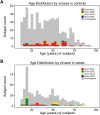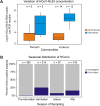Human coronaviruses associated with upper respiratory tract infections in three rural areas of Ghana
- PMID: 25080241
- PMCID: PMC4117488
- DOI: 10.1371/journal.pone.0099782
Human coronaviruses associated with upper respiratory tract infections in three rural areas of Ghana
Abstract
Background: Acute respiratory tract infections (ARI) are the leading cause of morbidity and mortality in developing countries, especially in Africa. This study sought to determine whether human coronaviruses (HCoVs) are associated with upper respiratory tract infections among older children and adults in Ghana.
Methods: We conducted a case control study among older children and adults in three rural areas of Ghana using asymptomatic subjects as controls. Nasal/Nasopharyngeal swabs were tested for Middle East respiratory syndrome coronavirus (MERS-CoV), HCoV-22E, HCoV-OC43, HCoV-NL63 and HCoV-HKU1 using Reverse Transcriptase Real-Time Polymerase Chain Reaction.
Results: Out of 1,213 subjects recruited, 150 (12.4%) were positive for one or more viruses. Of these, single virus detections occurred in 146 subjects (12.0%) and multiple detections occurred in 4 (0.3%). Compared with control subjects, infections with HCoV-229E (OR = 5.15, 95%CI = 2.24-11.78), HCoV-OC43 (OR = 6.16, 95%CI = 1.77-21.65) and combine HCoVs (OR = 2.36, 95%CI = 1.5 = 3.72) were associated with upper respiratory tract infections. HCoVs were found to be seasonally dependent with significant detections in the harmattan season (mainly HCoV-229E) and wet season (mainly HCoV-NL63). A comparison of the obtained sequences resulted in no differences to sequences already published in GenBank.
Conclusion: HCoVs could play significant role in causing upper respiratory tract infections among adults and older children in rural areas of Ghana.
Conflict of interest statement
Figures



References
-
- Denny FW, Loda FA (1986) Acute respiratory infections are the leading cause of death in children in developing countries. The American journal of tropical medicine and hygiene 35: 1–2. - PubMed
-
- Williams BG, Gouws E, Boschi-Pinto C, Bryce J, Dye C (2002) Estimates of world-wide distribution of child deaths from acute respiratory infections. The Lancet infectious diseases 2: 25–32. - PubMed
-
- Gessner BD (2011) Acute lower respiratory infection in the developing world. Expert Review of Respiratory Medicine 5: 459–463. - PubMed
-
- Xiao NG, Zhang B, Duan ZJ, Xie ZP, Zhou QH, et al. (2012) [Viral etiology of 1165 hospitalized children with acute lower respiratory tract infection]. Zhongguo Dang Dai Er Ke Za Zhi 14: 28–32. - PubMed
Publication types
MeSH terms
LinkOut - more resources
Full Text Sources
Other Literature Sources

